

Compact Muon Solenoid
LHC, CERN
| CMS-PAS-SUS-16-048 | ||
| Search for new physics in events with two low momentum opposite-sign leptons and missing transverse energy at $\sqrt{s}= $ 13 TeV | ||
| CMS Collaboration | ||
| March 2017 | ||
| Abstract: A search for new physics in events with low-momentum opposite-sign leptons and missing transverse momentum, using 35.9 fb$^{-1}$ of integrated luminosity collected by CMS experiment at $\sqrt{s}= $ 13 TeV, is presented. The data observed are consistent with expectations from the standard model. The results are interpreted in terms of pair production of charginos and neutralinos ($\tilde{\chi}_1^{\pm}$, $\tilde{\chi}_2^{0}$) with nearly degenerate masses, as expected in natural compressed higgsino models, and in terms of the pair production of top squarks for the case that the neutralino and the top squark have similar masses. At 95% confidence level, $\tilde{\chi}_1^{\pm}$/$\tilde{\chi}_2^{0}$ are excluded for masses up to 230 GeV for a mass difference of 20 GeV with respect to the lightest neutralino, which is a region constrained so far by the LEP experiments only. An interpretation is also provided in terms of top squark ($\tilde{t}$) pair production processes with degenerate mass spectra and chargino-mediated decays. Masses of the $\tilde{t}$ up to 450 GeV are excluded for a mass difference of 40 GeV with respect to the lightest neutralino. | ||
|
Links:
CDS record (PDF) ;
inSPIRE record ;
CADI line (restricted) ;
These preliminary results are superseded in this paper, PLB 782 (2018) 440. The superseded preliminary plots can be found here. |
||
| Figures & Tables | Summary | Additional Figures & Tables | References | CMS Publications |
|---|
| Additional information on efficiencies needed for reinterpretation of these results are available here. Additional technical material for CMS speakers can be found here |
| Figures | |

png pdf |
Figure 1:
Left: electroweakino pair production and decay. Right: chargino-mediated $\tilde{ \mathrm{ t } }$ pair production and decay. |
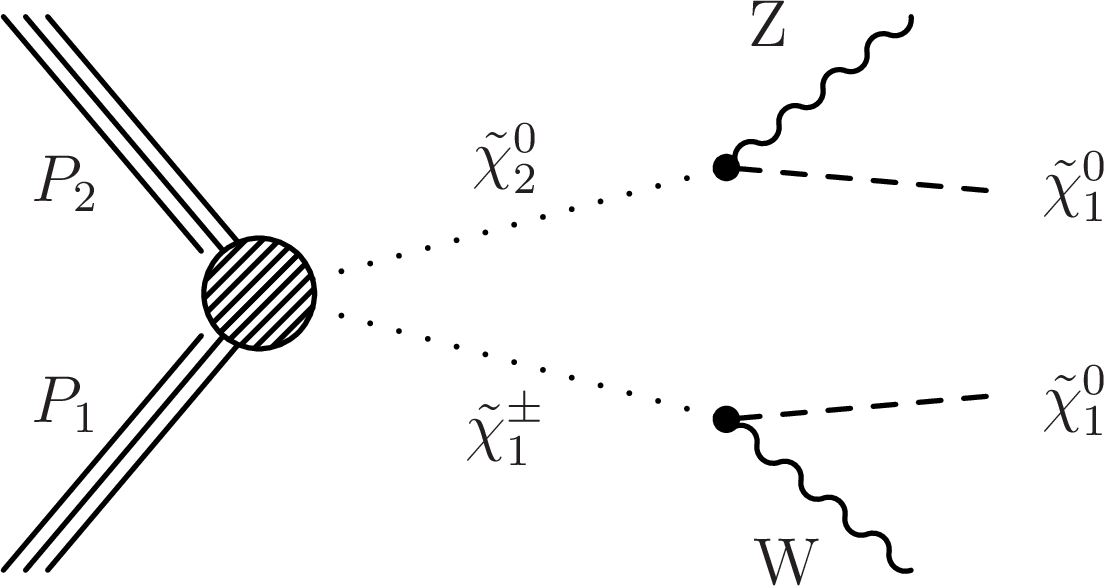
png pdf |
Figure 1-a:
Electroweakino pair production and decay. |
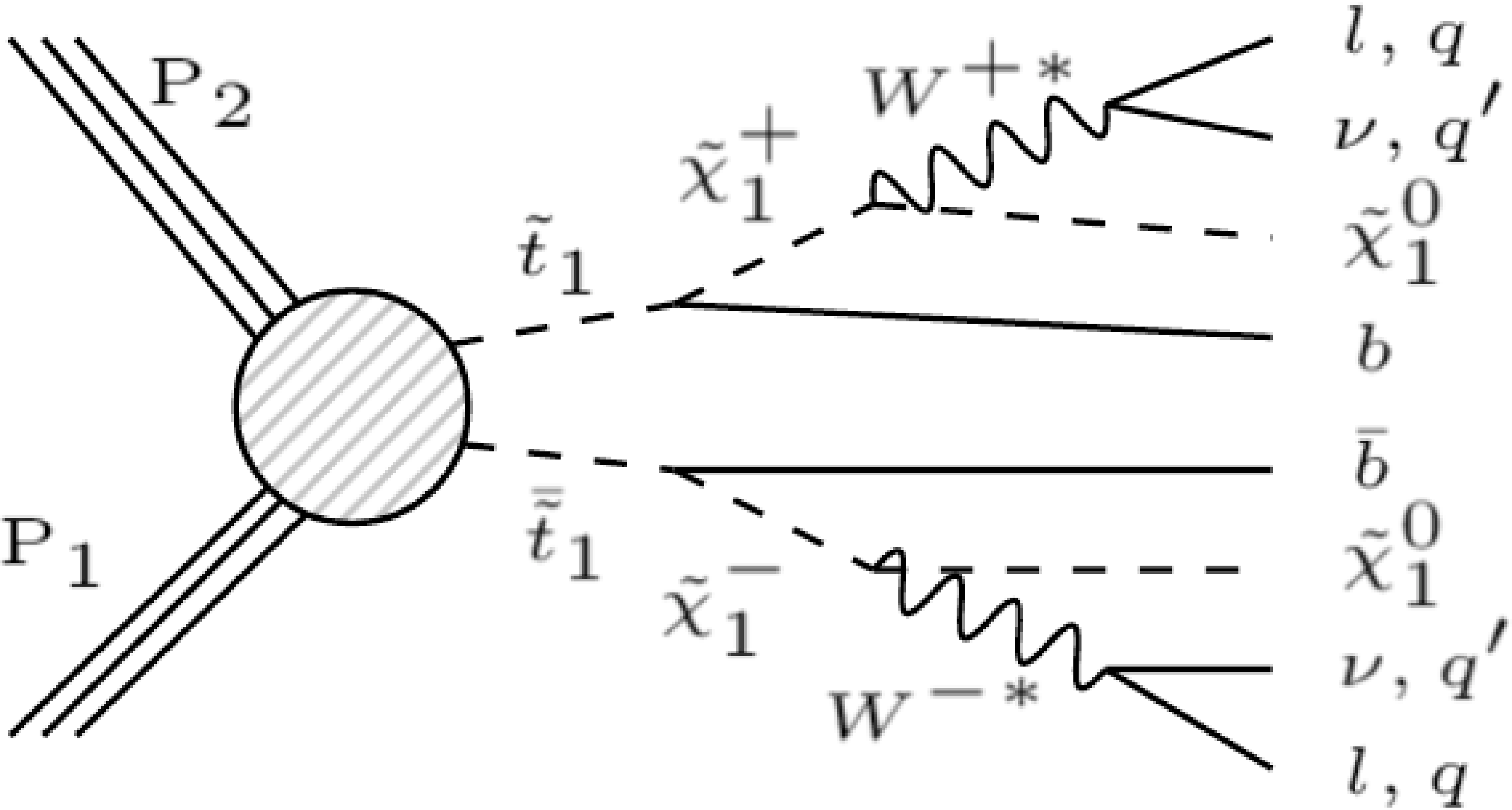
png pdf |
Figure 1-b:
Chargino-mediated $\tilde{ \mathrm{ t } }$ pair production and decay. |

png pdf |
Figure 2:
Same-sign control region for $ \tilde{ \mathrm{ t } } $ selection and $ {E_{\mathrm {T}}^{\text {miss}}} > $ 200 GeV. The shape of of the leading lepton pT is used as input to the final signal extraction. The superimposed signal is from $ \tilde{ \mathrm{ t } } $ pair production where the mass of the $ \tilde{ \mathrm{ t } } $ is 350 GeV and the difference in mass with the lightest neutralino is 20 GeV (T2tt350/20). |
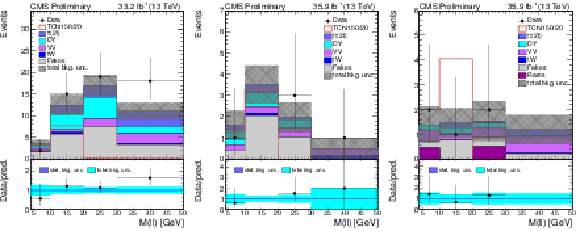
png pdf |
Figure 3:
Left: Electroweakino search region for 125 $ < {E_{\mathrm {T}}^{\text {miss}}} < $ 200 GeV (muon only channel) for 33.2 fb$^{-1}$ ; Middle: 200 $ < {E_{\mathrm {T}}^{\text {miss}}} < $ 250 GeV (muon and electron channel) for 35.9 fb$^{-1}$ ; Right: $ {E_{\mathrm {T}}^{\text {miss}}} > $ 250 GeV (muon and electron channel) for 35.9 fb$^{-1}$. The superimposed signal is from neutralino-chargino ($ \tilde{ \chi }^0 _2$-$ \tilde{ \chi }^{\pm} _1$) pair production where the mass of the chargino is 150 GeV and the difference in mass with the lightest neutralino is 20 GeV (TChi150/20). |
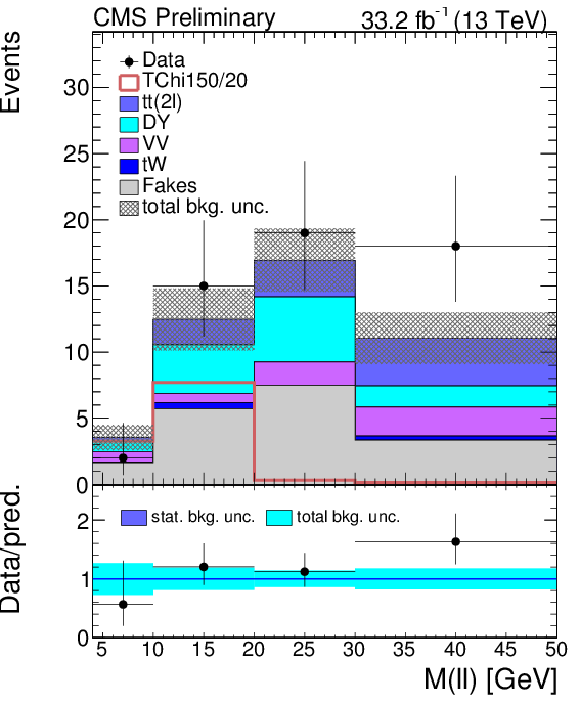
png pdf |
Figure 3-a:
Electroweakino search region for 125 $ < {E_{\mathrm {T}}^{\text {miss}}} < $ 200 GeV (muon only channel) for 33.2 fb$^{-1}$. The superimposed signal is from neutralino-chargino ($ \tilde{ \chi }^0 _2$-$ \tilde{ \chi }^{\pm} _1$) pair production where the mass of the chargino is 150 GeV and the difference in mass with the lightest neutralino is 20 GeV (TChi150/20). |
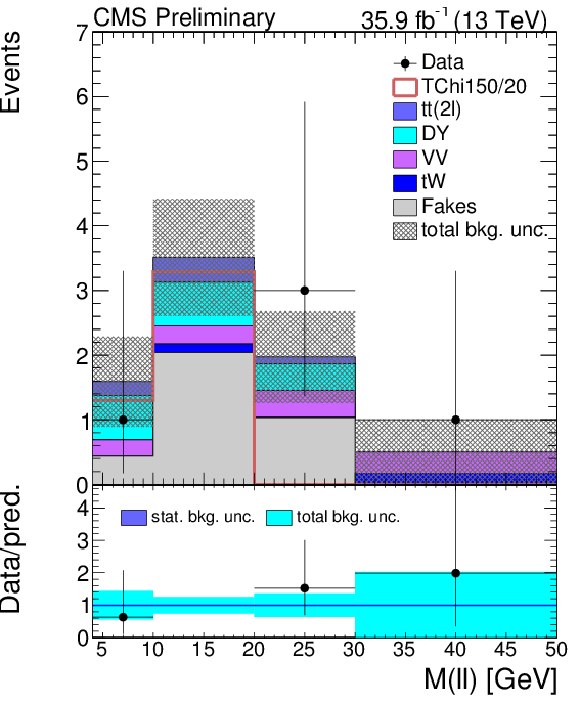
png pdf |
Figure 3-b:
Electroweakino search region for 200 $ < {E_{\mathrm {T}}^{\text {miss}}} < $ 250 GeV (muon and electron channel) for 35.9 fb$^{-1}$. The superimposed signal is from neutralino-chargino ($ \tilde{ \chi }^0 _2$-$ \tilde{ \chi }^{\pm} _1$) pair production where the mass of the chargino is 150 GeV and the difference in mass with the lightest neutralino is 20 GeV (TChi150/20). |

png pdf |
Figure 3-c:
Electroweakino search region for $ {E_{\mathrm {T}}^{\text {miss}}} > $ 250 GeV (muon and electron channel) for 35.9 fb$^{-1}$. The superimposed signal is from neutralino-chargino ($ \tilde{ \chi }^0 _2$-$ \tilde{ \chi }^{\pm} _1$) pair production where the mass of the chargino is 150 GeV and the difference in mass with the lightest neutralino is 20 GeV (TChi150/20). |
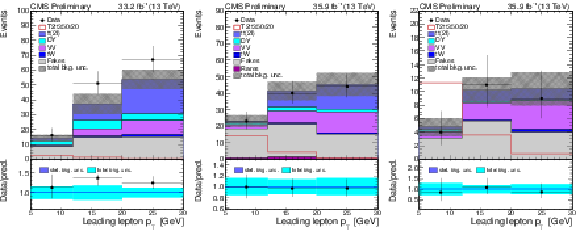
png pdf |
Figure 4:
Left: $ \tilde{ \mathrm{ t } } $ search region for 125 $ < {E_{\mathrm {T}}^{\text {miss}}} < $ 200 GeV (muon only channel) for 33.2 fb$^{-1}$ ; Middle: 200 $ < {E_{\mathrm {T}}^{\text {miss}}} < $ 300 GeV (muon and electron channel) for 35.9 fb$^{-1}$ ; Right: $ {E_{\mathrm {T}}^{\text {miss}}} > $ 300 GeV (muon and electron channel) for 35.9 fb$^{-1}$. The superimposed signal is from $ \tilde{ \mathrm{ t } } $ pair production where the mass of the $ \tilde{ \mathrm{ t } } $ is 350 GeV and the difference in mass with the lightest neutralino is 20 GeV (T2tt350/20). |
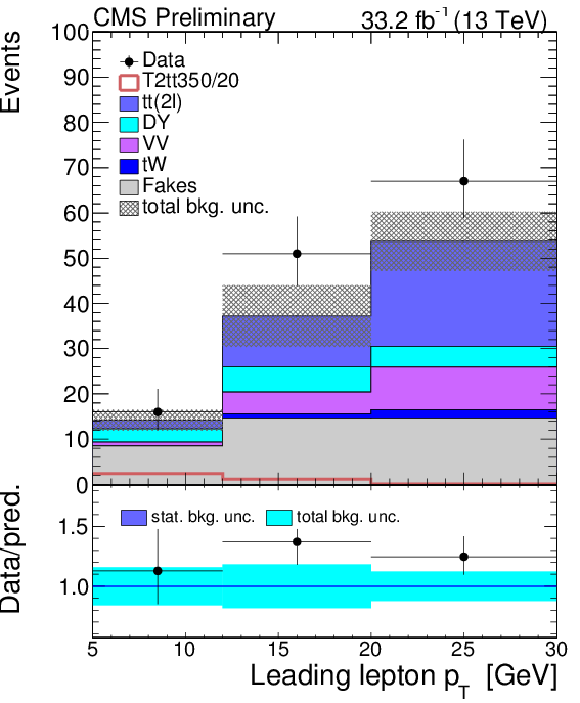
png pdf |
Figure 4-a:
$ \tilde{ \mathrm{ t } } $ search region for 125 $ < {E_{\mathrm {T}}^{\text {miss}}} < $ 200 GeV (muon only channel) for 33.2 fb$^{-1}$. The superimposed signal is from $ \tilde{ \mathrm{ t } } $ pair production where the mass of the $ \tilde{ \mathrm{ t } } $ is 350 GeV and the difference in mass with the lightest neutralino is 20 GeV (T2tt350/20). |
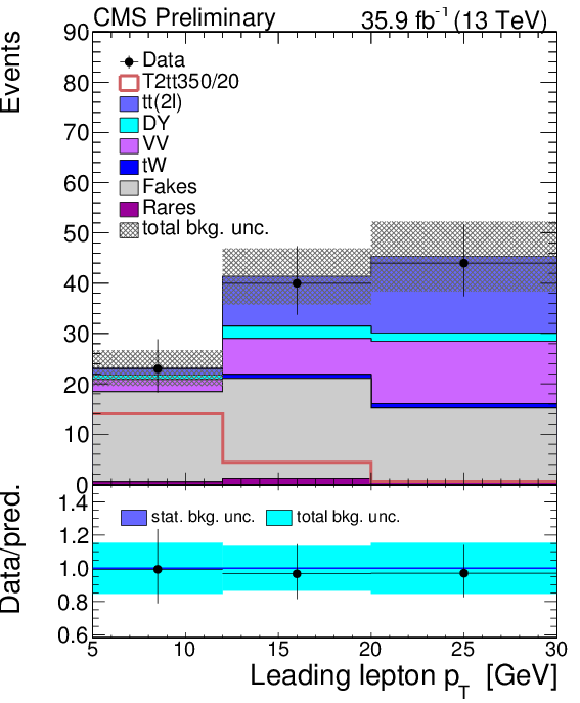
png pdf |
Figure 4-b:
$ \tilde{ \mathrm{ t } } $ search region for 200 $ < {E_{\mathrm {T}}^{\text {miss}}} < $ 300 GeV (muon and electron channel) for 35.9 fb$^{-1}$. The superimposed signal is from $ \tilde{ \mathrm{ t } } $ pair production where the mass of the $ \tilde{ \mathrm{ t } } $ is 350 GeV and the difference in mass with the lightest neutralino is 20 GeV (T2tt350/20). |
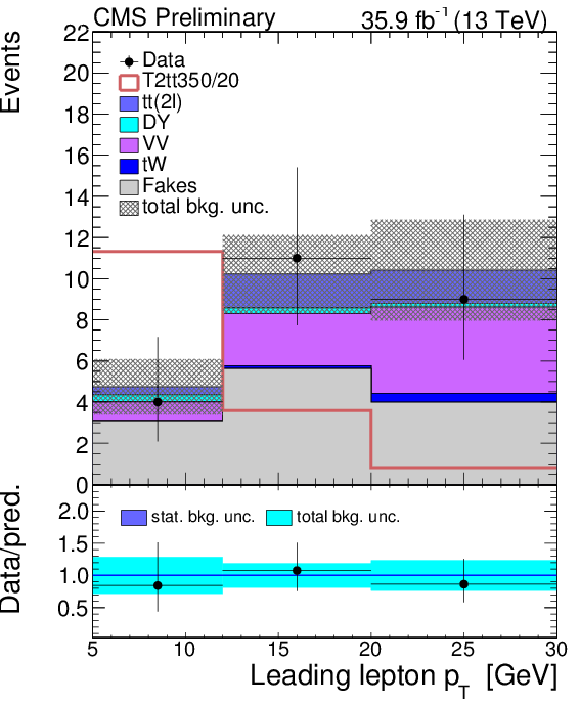
png pdf |
Figure 4-c:
$ \tilde{ \mathrm{ t } } $ search region for $ {E_{\mathrm {T}}^{\text {miss}}} > $ 300 GeV (muon and electron channel) for 35.9 fb$^{-1}$. The superimposed signal is from $ \tilde{ \mathrm{ t } } $ pair production where the mass of the $ \tilde{ \mathrm{ t } } $ is 350 GeV and the difference in mass with the lightest neutralino is 20 GeV (T2tt350/20). |

png pdf |
Figure 5:
The observed exclusion contours (black curves) assuming the NLO+NNL cross sections, with the corresponding 1 standard deviation uncertainties for electroweakino (left) and $ \tilde{ \mathrm{ t } } $ (right) search. The dashed (red) curves present the expected limits with 1 standard deviation experimental uncertainties. For the electroweakino search, results are based on a simplified model of $ \tilde{ \chi }^0 _2 \tilde{ \chi }^{\pm} _0 \rightarrow \tilde{ \chi }^0 _1 \tilde{ \chi }^0 _1 Z^{*}W^{*}$ process with a pure Wino production cross section, while a simplified model of the $ \tilde{ \mathrm{ t } } $ pair production, followed by the $ \tilde{ \mathrm{ t } } \rightarrow \tilde{ \chi }^{\pm} _1 \mathrm {b}$ and the subsequent $ \tilde{ \chi }^{\pm} _1 \rightarrow \tilde{ \chi }^0 _1 W^{*}$ decay is used for the $ \tilde{ \mathrm{ t } } $ search. In this last model, the mass of the $ \tilde{ \chi }^{\pm} _1$ is set to be $ (M_{ \tilde{ \mathrm{ t } } } + M_{ \tilde{ \chi }^0 _1})/2$. Data corresponds to an integrated luminosity ranging from 33.2 fb$^{-1}$ to 35.9 fb$^{-1}$. |

png pdf root |
Figure 5-a:
The observed exclusion contours (black curves) assuming the NLO+NNL cross sections, with the corresponding 1 standard deviation uncertainties for the electroweakino search. The dashed (red) curves present the expected limits with 1 standard deviation experimental uncertainties. Results are based on a simplified model of $ \tilde{ \chi }^0 _2 \tilde{ \chi }^{\pm} _0 \rightarrow \tilde{ \chi }^0 _1 \tilde{ \chi }^0 _1 Z^{*}W^{*}$ process with a pure Wino production cross section. Data corresponds to an integrated luminosity ranging from 33.2 fb$^{-1}$ to 35.9 fb$^{-1}$. |
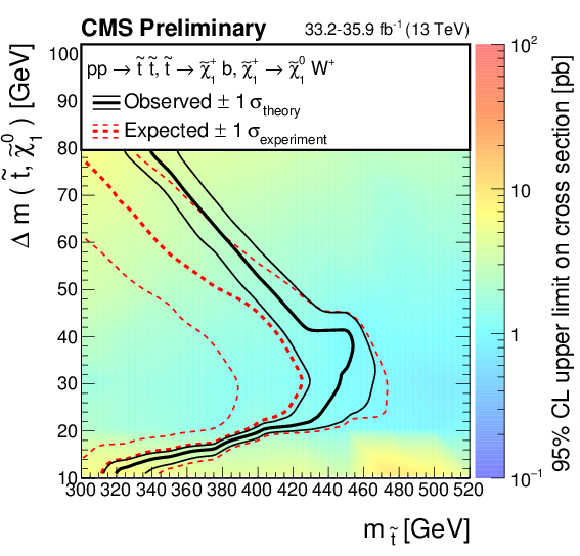
png pdf root |
Figure 5-b:
The observed exclusion contours (black curves) assuming the NLO+NNL cross sections, with the corresponding 1 standard deviation uncertainties for the $ \tilde{ \mathrm{ t } } $ search. The dashed (red) curves present the expected limits with 1 standard deviation experimental uncertainties. A simplified model of the $ \tilde{ \mathrm{ t } } $ pair production, followed by the $ \tilde{ \mathrm{ t } } \rightarrow \tilde{ \chi }^{\pm} _1 \mathrm {b}$ and the subsequent $ \tilde{ \chi }^{\pm} _1 \rightarrow \tilde{ \chi }^0 _1 W^{*}$ decay is used. In this last model, the mass of the $ \tilde{ \chi }^{\pm} _1$ is set to be $ (M_{ \tilde{ \mathrm{ t } } } + M_{ \tilde{ \chi }^0 _1})/2$. Data corresponds to an integrated luminosity ranging from 33.2 fb$^{-1}$ to 35.9 fb$^{-1}$. |
| Tables | |

png pdf |
Table 1:
Selection requirements for the signal regions. The subleading lepton ${p_{\mathrm {T}}}$ threshold is reduced to 3.5 GeV for muons in the high ${E_{\mathrm {T}}^{\text {miss}}} \tilde{ \mathrm{ t } } $-like signal region. $Iso_{\text {rel}}$ and $Iso_{\text {abs}}$ are relative and absolute isolation variables. |

png pdf |
Table 2:
Summary of selection of control regions and the WW validation region (VR). |

png pdf |
Table 3:
Data and simulation yields for the DY and ${\mathrm{ t } {}\mathrm{ \bar{t} } } $ control regions corresponding to a integrated luminosity of 35.9 fb$^{-1}$ (high ${E_{\mathrm {T}}^{\text {miss}}}$ region) and 33.2 fb$^{-1}$ (low ${E_{\mathrm {T}}^{\text {miss}}}$ region). Uncertainties are statistical. |
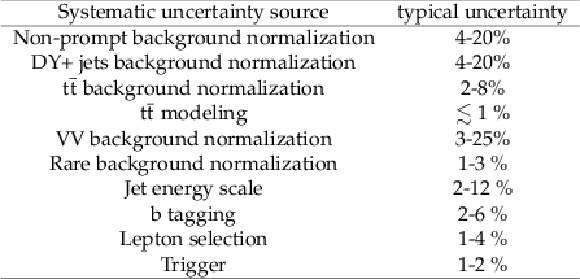
png pdf |
Table 4:
Relative uncertainties on the final predictions for each individual systematic uncertainty source. |
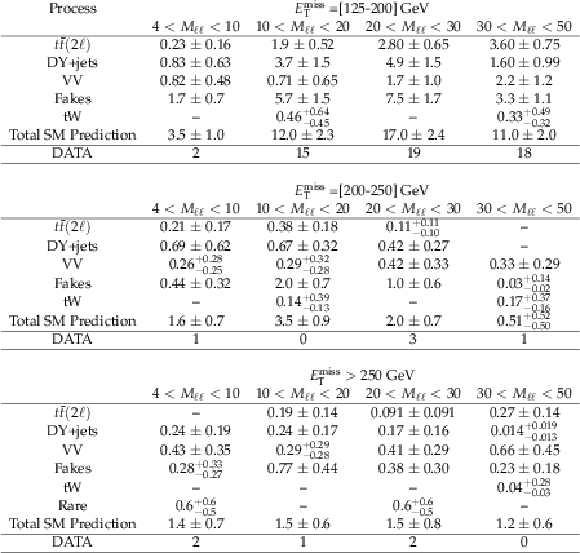
png pdf |
Table 5:
Predicted and data yields with uncertainty from the fit for the electroweakino search region for 33.2 fb$^{-1}$ and 35.9 fb$^{-1}$ of integrated luminosity. |

png pdf |
Table 6:
Predicted and data yields with uncertainty from the fit for the $ \tilde{ \mathrm{ t } } $ search region for 33.2 fb$^{-1}$ and 35.9 fb$^{-1}$ of integrated luminosity. |
| Summary |
| A search for new physics in events with two low momentum opposite-sign leptons and missing transverse energy is presented using the data collected by CMS at a a center-of-mass energy of 13 TeV and corresponding to an integrated luminosity of up to 35.9 fb$^{-1}$. The data are found to be consistent with the standard model expectations. The results are interpreted in the framework of supersymmetric simplified models targeting electroweakino mass-degenerate spectra and $\tilde{\mathrm{t}}$-$\tilde{\chi}^0_1$ mass-degenerate benchmark scenarios. The search probes the $\tilde{\chi}^0_2\tilde{\chi}^{\pm}_1\rightarrow \tilde{\chi}^0_1\tilde{\chi}^0_1 Z^{*}W^{*}$ process for mass differences ($\Delta$m) between $\tilde{\chi}^0_2$ and $\tilde{\chi}^0_1$ of less than 20 GeV. Assuming Wino production cross sections, $\tilde{\chi}^0_2$ masses up to 230 GeV are excluded for $\Delta$m of 20 GeV. For the $\tilde{\mathrm{t}}$ chargino-mediated decay into $\tilde{\chi}^0_1 W^{*}$, $\tilde{\mathrm{t}}$ masses of up to 450 GeV are excluded for a $\Delta$m$(\tilde{\mathrm{t}},\tilde{\chi}^0_1)$ = 40 GeV assuming a simplified description of the model. |
| Additional Figures | |

png pdf root |
Additional Figure 1:
Covariance matrix for the expected backgrounds from the predictive fit in the electroweakino search region. |
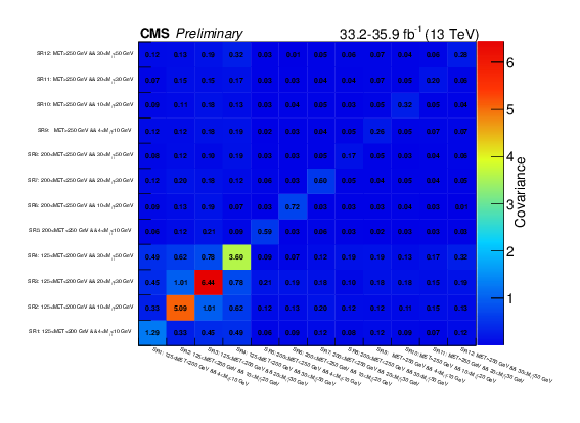
png pdf |
Additional Figure 2:
Covariance matrix for the expected backgrounds from the predictive fit in the electroweakino search region (text version). |

png pdf root |
Additional Figure 3:
Covariance matrix for the expected backgrounds from the predictive fit in the $\tilde{t}$ search region. |

png pdf |
Additional Figure 4:
Covariance matrix for the expected backgrounds from the predictive fit in the $\tilde{t}$ search region (text version). |
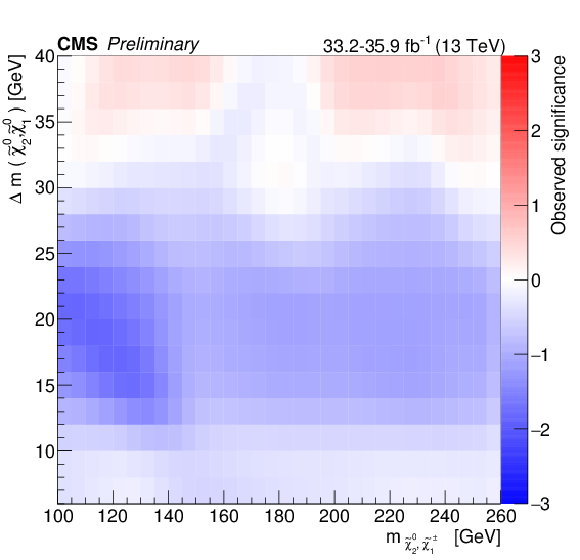
png pdf |
Additional Figure 5:
Observed significance in the electroweakino plane, based on a simplified model of $\tilde{\chi }_2^{0} \tilde{\chi }_1^{\pm } \rightarrow \tilde{\chi }_1^{0}\tilde{\chi }_1^{0} Z^{*}W^{*}$ with a pure Wino production cross section. Data corresponds to an integrated luminosity ranging from 33.2 fb$^{-1}$ to 35.9 fb$^{-1}$ . |

png pdf |
Additional Figure 6:
Observed significance in the $\tilde{t}$ plane, based on a simplified model of $\tilde{t}$ pair production, followed by the $\tilde{t} \rightarrow \tilde{\chi }_1^{\pm } \mathrm {b}$ and the subsequent $ \tilde{\chi }_1^{\pm } \rightarrow \tilde{\chi }_1^{0} W^{*}$ decay. The mass of the $ \tilde{\chi }_1^{\pm }$ is set to be $ (M_{\tilde{t}} + M_{\tilde{\chi }_1^{0}})/2$. Data corresponds to an integrated luminosity ranging from 33.2 fb$^{-1}$ to 35.9 fb$^{-1}$. |
| Additional Tables | |

png pdf |
Additional Table 1:
Cut-flow of yields for one of the search regions, corresponding to 33.2 fb$^{-1}$ of integrated luminosity for various signal model points, given as the mass pair ($\tilde{\chi }_2^{0}$,$\tilde{\chi }_1^{0}$) or ($\tilde{t}$,$\tilde{\chi }_1^{0}$). The yields are normalized to the theoretical cross sections. The "All events'' category below starts from all generated events where the Z boson decays leptonically. |
| References | ||||
| 1 | J. Wess and B. Zumino | Supergauge transformations in four dimensions | Nucl. Phys. B 70 (1974) 39 | |
| 2 | H. P. Nilles | Supersymmetry, supergravity and particle physics | Phys. Reports 110 (1984) 1 | |
| 3 | H. E. Haber and G. L. Kane | The search for supersymmetry: Probing physics beyond the standard model | Phys. Reports 117 (1985) 75 | |
| 4 | R. Barbieri, S. Ferrara, and C. A. Savoy | Gauge models with spontaneously broken local supersymmetry | PLB 119 (1982) 343 | |
| 5 | S. Dawson, E. Eichten, and C. Quigg | Search for supersymmetric particles in hadron-hadron collisions | PRD 31 (1985) 1581 | |
| 6 | E. Witten | Dynamical breaking of supersymmetry | Nucl. Phys. B 188 (1981) 513 | |
| 7 | S. Dimopoulos and H. Georgi | Softly broken supersymmetry and SU(5) | Nucl. Phys. B 193 (1981) 150 | |
| 8 | G. R. Farrar and P. Fayet | Phenomenology of the production, decay, and detection of new hadronic states associated with supersymmetry | PLB 76 (1978) 575 | |
| 9 | R. Barbieri and G. Giudice | Upper bounds on supersymmetric particle masses | Nucl. Phys. B 306 (1988) 63 | |
| 10 | B. de Carlos and J. Casas | One-loop analysis of the electroweak breaking in supersymmetric models and the fine-tuning problem | PLB 309 (1993) 320 | hep-ph/9303291 |
| 11 | M. Dine, W. Fischler, and M. Srednicki | Supersymmetric technicolor | Nucl. Phys. B 189 (1981) 575 | |
| 12 | S. Dimopoulos and S. Raby | Supercolor | Nucl. Phys. B 192 (1981) 353 | |
| 13 | N. Sakai | Naturalness in supersymmetric GUTS | Z. Phys. C 11 (1981) 153 | |
| 14 | R. K. Kaul and P. Majumdar | Cancellation of quadratically divergent mass corrections in globally supersymmetric spontaneously broken gauge theories | Nucl. Phys. B 199 (1982) 36 | |
| 15 | H. Baer, A. Mustafayev, and X. Tata | Monojet plus soft dilepton signal from light higgsino pair production at LHC14 | PRD 90 (2014) 115007 | 1409.7058 |
| 16 | G. F. Giudice, T. Han, K. Wang, and L.-T. Wang | Nearly degenerate gauginos and dark matter at the LHC | PRC 81 (2010) 115011 | 1004.4902 |
| 17 | Z. Han, G. D. Kribs, A. Martin, and A. Menon | Hunting quasidegenerate Higgsinos | PRD 89 (2014) 075007 | 1401.1235 |
| 18 | ALEPH Collaboration | Search for charginos nearly mass degenerate with the lightest neutralino in e+ e- collisions at center-of-mass energies up to 209-GeV | PLB533 (2002) 223--236 | hep-ex/0203020 |
| 19 | DELPHI Collaboration | Searches for supersymmetric particles in e+ e- collisions up to 208-GeV and interpretation of the results within the MSSM | EPJC31 (2003) 421--479 | hep-ex/0311019 |
| 20 | P. Schwaller and J. Zurita | Compressed electroweakino spectra at the LHC | JHEP 03 (2014) 060 | 1312.7350 |
| 21 | R. Grober, M. M. Muhlleitner, E. Popenda, and A. Wlotzka | Light Stop Decays: Implications for LHC Searches | EPJC 75 (2015) 420 | 1408.4662 |
| 22 | C. Bal\'azs, M. Carena, and C. E. M. Wagner | Dark matter, light stops and electroweak baryogenesis | PRD 70 (2004) 015007 | hep-ph/0403224 |
| 23 | CMS Collaboration | Searches for third-generation squark production in fully hadronic final states in proton-proton collisions at $ \sqrt{s} = $ 8 TeV | JHEP 06 (2015) 116 | CMS-SUS-14-001 1503.08037 |
| 24 | ATLAS Collaboration | Search for top squark pair production in final states with one isolated lepton, jets, and missing transverse momentum in $ \sqrt{s} = $ 8 TeV $ \mathrm{ p }\mathrm{ p } $ collisions with the ATLAS detector | JHEP 11 (2014) 118 | 1407.0583 |
| 25 | ATLAS Collaboration | Search for pair-produced third-generation squarks decaying via charm quarks or in compressed supersymmetric scenarios in $ \mathrm{ p }\mathrm{ p } $ collisions at $ \sqrt{s}= $ 8 TeV with the ATLAS detector | PRD 90 (2014) 052008 | 1407.0608 |
| 26 | CMS Collaboration | Search for supersymmetry in events with soft leptons, low jet multiplicity, and missing transverse energy in proton–proton collisions at $ \sqrt{s} $=8 TeV | PLB759 (2016) | CMS-SUS-14-021 1512.08002 |
| 27 | CMS Collaboration | The CMS Experiment at the CERN LHC | JINST 3 (2008) S08004 | CMS-00-001 |
| 28 | J. Alwall et al. | MadGraph5: going beyond | JHEP 06 (2011) 128 | 1106.0522 |
| 29 | NNPDF Collaboration | Parton distributions for the LHC Run II | JHEP 04 (2015) 040 | 1410.8849 |
| 30 | J. Alwall et al. | The automated computation of tree-level and next-to-leading order differential cross sections, and their matching to parton shower simulations | JHEP 07 (2014) 079 | 1405.0301 |
| 31 | P. Nason | A new method for combining NLO QCD with shower Monte Carlo algorithms | JHEP 11 (2004) 040 | hep-ph/0409146 |
| 32 | S. Frixione, P. Nason, and C. Oleari | Matching NLO QCD computations with parton shower simulations: the POWHEG method | JHEP 11 (2007) 070 | 0709.2092 |
| 33 | S. Alioli, P. Nason, C. Oleari, and E. Re | A general framework for implementing NLO calculations in shower Monte Carlo programs: the POWHEG BOX | JHEP 06 (2010) 043 | 1002.2581 |
| 34 | S. Alioli, P. Nason, C. Oleari, and E. Re | NLO single-top production matched with shower in POWHEG: $ s $- and $ t $-channel contributions | JHEP 09 (2009) 111, , [Erratum: JHEP \bf 02 (2010) 011] | 0907.4076 |
| 35 | E. Re | Single-top Wt-channel production matched with parton showers using the POWHEG method | EPJC 71 (2011) 1547 | 1009.2450 |
| 36 | T. Sjostrand et al. | An Introduction to PYTHIA 8.2 | CPC 191 (2015) 159 | 1410.3012 |
| 37 | S. Agostinelli et al. | GEANT4 --- a simulation toolkit | Nucl. Instr. and Meth. A 506 (2003) 250 | |
| 38 | CMS Collaboration | The Fast Simulation of the CMS Detector at LHC | Technical Report 3, CERN | |
| 39 | B. Fuks, M. Klasen, D. R. Lamprea, and M. Rothering | Gaugino production in proton-proton collisions at a center-of-mass energy of 8 TeV | JHEP 10 (2012) 081 | 1207.2159 |
| 40 | B. Fuks, M. Klasen, D. R. Lamprea, and M. Rothering | Precision predictions for electroweak superpartner production at hadron colliders with Resummino | EPJC 73 (2013) 2480 | 1304.0790 |
| 41 | CMS Collaboration | Particle--Flow Event Reconstruction in CMS and Performance for Jets, Taus, and $ E_{\mathrm{T}}^{\text{miss}} $ | CDS | |
| 42 | E. Chabanat and N. Estre | Deterministic Annealing for Vertex Finding at CMS | ||
| 43 | CMS Collaboration | Performance of CMS muon reconstruction in $ \mathrm{ p }\mathrm{ p } $ collision events at $ \sqrt{s} = $ 7 TeV | JINST 7 (2012) P10002 | CMS-MUO-10-004 1206.4071 |
| 44 | CMS Collaboration | Studies of Higgs boson production in the four-lepton final state at $ \sqrt{s}= $ 13 TeV | CMS-PAS-HIG-15-004 | CMS-PAS-HIG-15-004 |
| 45 | M. Cacciari, G. P. Salam, and G. Soyez | The anti-$ k_t $ jet clustering algorithm | JHEP 04 (2008) 063 | 0802.1189 |
| 46 | CMS Collaboration | Identification of b quark jets at the CMS Experiment in the LHC Run 2 | CMS-PAS-BTV-15-001 | CMS-PAS-BTV-15-001 |
| 47 | CMS Collaboration | Search for new physics with same-sign isolated dilepton events with jets and missing transverse energy at the LHC | JHEP 06 (2011) 077 | CMS-SUS-10-004 1104.3168 |
| 48 | ATLAS Collaboration | Measurement of spin correlation in top-antitop quark events and search for top squark pair production in $ \mathrm{ p }\mathrm{ p } $ collisions at $ \sqrt{s} = $ 8 TeV using the ATLAS detector | PRL 114 (2015) 142001 | 1412.4742 |
| 49 | CMS Collaboration | Measurements of t t-bar spin correlations and top quark polarization using dilepton final states in pp collisions at $ \sqrt{s} $ = 8 TeV | PRD 93 (2016), no. 5, 052007 | CMS-TOP-14-023 1601.01107 |
| 50 | G. Cowan, K. Cranmer, E. Gross, and O. Vitells | Asymptotic formulae for likelihood-based tests of new physics | EPJC 71 (2011) 1554, , [Erratum: Eur. Phys. J.C73,2501(2013)] | 1007.1727 |
| 51 | T. Junk | Confidence level computation for combining searches with small statistics | Nucl. Instr. and Meth. A 434 (1999) 435 | hep-ex/9902006 |
| 52 | A. L. Read | Presentation of search results: the $ {CL}_s $ technique | JPG 28 (2002) 2693 | |

|
Compact Muon Solenoid LHC, CERN |

|

|

|

|

|

|